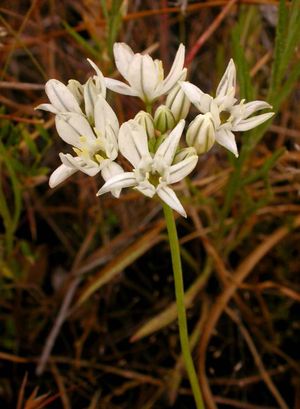Difference between revisions of "Triteleia hyacinthina"
m (Tag: VisualEditor) |
m (Tag: VisualEditor) |
||
| Line 1: | Line 1: | ||
[[File:TRIHYA3.jpg|thumb|Photo: Ben Legler 2004]] | [[File:TRIHYA3.jpg|thumb|Photo: Ben Legler 2004]] | ||
| − | + | * Scientific Name: ''Tritelia hyacinthina'' (Lindl.) Greene | |
| + | * Family: Asparagaceae. | ||
| + | * Common Names: fools' onion, hyacinth brodiaea, hyacinth triplet-Lily, white Brodiaea | ||
| + | * Codon: TRIHYA | ||
| + | * Synonyms/Misapplications: Brodiaea hyacinthina | ||
| + | |||
==Taxonomy== | ==Taxonomy== | ||
{{Taxobox | {{Taxobox | ||
| Line 20: | Line 25: | ||
Scapose herbs growing from fibrous corms. 6 tepals alike. Flowers few to many in an open, bracteate umbel, perianth 6-16mm, connate up to half the length. white or tinged with blue, the tube shallowly bowl-shaped, lobes with a narrow green midvein. Stamens 6, anthers pale yellow, rarely blue, filaments triangular, confluent at their bases. Leaves 1-2, flat | Scapose herbs growing from fibrous corms. 6 tepals alike. Flowers few to many in an open, bracteate umbel, perianth 6-16mm, connate up to half the length. white or tinged with blue, the tube shallowly bowl-shaped, lobes with a narrow green midvein. Stamens 6, anthers pale yellow, rarely blue, filaments triangular, confluent at their bases. Leaves 1-2, flat | ||
but keeled beneath, 3-10 mm broad and up to 4 dm long, not withered by | but keeled beneath, 3-10 mm broad and up to 4 dm long, not withered by | ||
| − | flowering. Fruit is a three-celled capsule, with a stype nearly as long. <ref name=":0">Hitchcock, C., Cronquist, | + | flowering. Fruit is a three-celled capsule, with a stype nearly as long. <ref name=":0">Hitchcock, C. L., Cronquist, A., Giblin, D., |
| − | Giblin, | + | & Legler, B. et al. (2018). ''Flora of the Pacific Northwest: an |
| − | + | illustrated manual''. Seattle: University of Washington Press</ref><ref name=":1">WTU Herbarium, Burke Museum, | |
| − | illustrated manual'' | + | |
| − | + | ||
& University of Washington. (n.d.). Retrieved from <nowiki>https://biology.burke.washington.edu/herbarium/imagecollection/taxon.php?Taxon=Triteleia%20hyacinthina</nowiki></ref> | & University of Washington. (n.d.). Retrieved from <nowiki>https://biology.burke.washington.edu/herbarium/imagecollection/taxon.php?Taxon=Triteleia%20hyacinthina</nowiki></ref> | ||
| Line 41: | Line 44: | ||
==Photo Gallery== | ==Photo Gallery== | ||
<gallery> | <gallery> | ||
| − | File: | + | File:TRIHYA4.jpg| 2004 Ben Legler |
File:TRIHYA2.jpg| 2004 Ben Legler | File:TRIHYA2.jpg| 2004 Ben Legler | ||
</gallery> | </gallery> | ||
Revision as of 15:32, 21 April 2020
- Scientific Name: Tritelia hyacinthina (Lindl.) Greene
- Family: Asparagaceae.
- Common Names: fools' onion, hyacinth brodiaea, hyacinth triplet-Lily, white Brodiaea
- Codon: TRIHYA
- Synonyms/Misapplications: Brodiaea hyacinthina
Contents
Taxonomy
| Triteleia hyacinthina | |
|---|---|
| Scientific classification | |
| Kingdom: | Plantae |
| Subkingdom: | Tracheobionta |
| Phylum: | Spermatophyta |
| Subphylum: | Magnoliophyta |
| Class: | Magnoliopsida |
| Subclass: | Lilianae |
| Order: | Asparagales |
| Family: | Asparagaceae |
| Genus: | Triteleia Lindl. |
| Species: | Triteleia hyacinthina (Lindl.) Greene |
Description
Scapose herbs growing from fibrous corms. 6 tepals alike. Flowers few to many in an open, bracteate umbel, perianth 6-16mm, connate up to half the length. white or tinged with blue, the tube shallowly bowl-shaped, lobes with a narrow green midvein. Stamens 6, anthers pale yellow, rarely blue, filaments triangular, confluent at their bases. Leaves 1-2, flat but keeled beneath, 3-10 mm broad and up to 4 dm long, not withered by flowering. Fruit is a three-celled capsule, with a stype nearly as long. [1][2]
Bloom Period
May-August[2]
Distribution
Southwest BC to coastal California, from coast inland to Idaho and eastern Oregon.[1]
Habitat
Sagebrush deserts and grassy, open, and often rocky areas from low to mid-elevations in the mountains.[2]
Uses
Food and Medicine: Ethnobotanical records of Pomo peoples and other nations eating the corms baked or boiled.[3]
Photo Gallery
References
- ↑ 1.0 1.1 Hitchcock, C. L., Cronquist, A., Giblin, D., & Legler, B. et al. (2018). Flora of the Pacific Northwest: an illustrated manual. Seattle: University of Washington Press
- ↑ 2.0 2.1 2.2 WTU Herbarium, Burke Museum, & University of Washington. (n.d.). Retrieved from https://biology.burke.washington.edu/herbarium/imagecollection/taxon.php?Taxon=Triteleia%20hyacinthina
- ↑ Native American Ethnobotany Database. (n.d.). Retrieved from http://naeb.brit.org/uses/search/?string=triteleia



